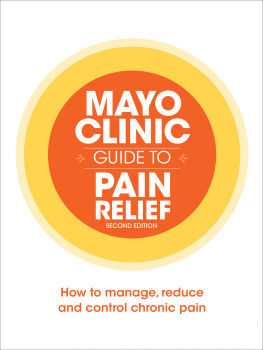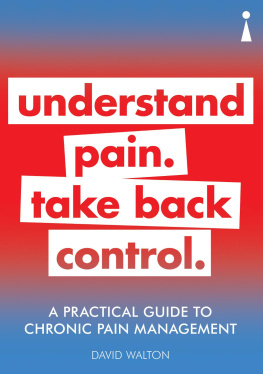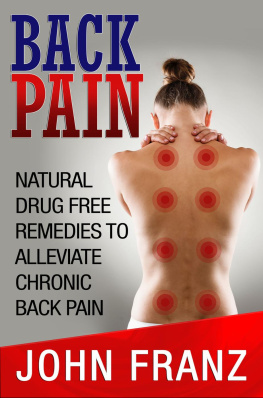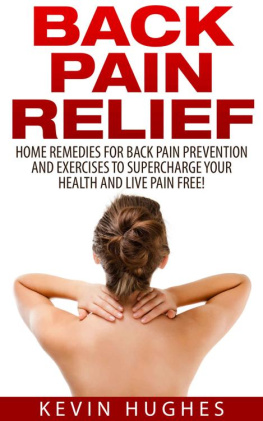Copyright 2016 by Skyhorse Publishing
First published in Spain by Grupo Ocano in 2011.
Original title: VENCER EL DOLOR DE FORMA NATURAL
Luis Aliaga Font, 2011
Editorial Ocano, S. L., 2012 (Barcelona, Spain)
Ocean Group Milanesat 21-2308017 Barcelona
Tel: 93 280 20 20Fax: 93 203 17 91
www.oceano.com
All rights reserved. No part of this publication may be reproduced or stored in a retrieval system or transmitted in any form or by any means, whether electronic, mechanical photocopying, recording or other kind, without the prior permission in writing of the owners.
All inquiries should be addressed to Skyhorse Publishing, 307 West 36th Street, 11th Floor, New York, NY 10018.
Skyhorse Publishing books may be purchased in bulk at special discounts for sales promotion, corporate gifts, fund-raising, or educational purposes. Special editions can also be created to specifications. For details, contact the Special Sales Department, Skyhorse Publishing, 307 West 36th Street, 11th Floor, New York, NY 10018 or .
Skyhorse and Skyhorse Publishing are registered trademarks of Skyhorse Publishing, Inc., a Delaware corporation.
Visit our website at www.skyhorsepublishing.com.
10 9 8 7 6 5 4 3 2 1
Library of Congress Cataloging-in-Publication Data is available on file.
Cover design by Jane Sheppard
Interior images by iStock
ISBN: 978-1-5107-0552-4
eBook ISBN: 978-1-5107-0557-9
Printed in the United States of America
Contents
Introduction
Pain, in one form or another, has always been a part of human life. Throughout history, mankind has sought solutions to help alleviate all kinds of pain, but we have only achieved partial or temporary relief. In the twenty-first century, experts still consider chronic pain one of the most concerning health problems affecting the population. Many of those who suffer musculoskeletal discomfort are not satisfied with their treatment. Seeing as over half of the population will suffer from arthritis or another rheumatic disease at some point in their life, this is not a very hopeful future.
Chronic pain can affect anyone. Throughout history, we have seen records from kings to painters, musicians to inventors, who have suffered from severe pain. Charles V, Holy Roman Emperor, suffered from severe attacks of gout that left him with a great physical disability; Christopher Columbus who lived for years in intense pain, suffering from strange symptoms, died at age fifty-four; and Sergei Rachmaninov, the last of the Romantic composers, though he suffered such severe pain that he could no longer compose music, discovered that performing on stage helped relieve the discomfort. Freud had migraines, Frida Kahlo was diagnosed with chronic pain, and Renoir had arthritis.
Many of those suffering from chronic pain feel misunderstood when they try to describe their symptoms, whether to their family, friends, or doctors. Often, their pain will be underestimated and left untreated. As a subjective sensation, pain is difficult to demonstrate. Patients are often passed from one specialist to another, only to be prescribed NSAIDS (nonsteroidal anti-inflammatories) to alleviate their chronic pain.
According to studies, it takes an average of two years for a patient to get proper treatment. Suffering from chronic pain for more than six months multiplies the risk of psychosocial impairment and disability, and causes a significant decrease in quality of life.
A study conducted in Spain on a population of five thousand people showed that 29 percent of the studys participants had pain the day before the study, and 43 percent reported having pain the week before the study. The incidence of pain increased with age, reaching 42 percent in people over sixty-five years old claiming that they suffered from pain daily. Professor Paul Langley of the University of Minnesota conducted the study Pain in Europe in 2003, which included more than fifty thousand people from various European countries. The study showed that 19 percent of participants suffered from chronic pain. This represents about 75 million people over the age of forty. In Spain, the percentage of people suffering from chronic pain was only recorded to be 12 percent; could this be because of the difference in lifestyle, food, and recreational activity?
In the United States, about 30 percent of the population suffers from back pain. About 70 million Americans develop chronic pain annually, with more than 50 million suffering partial or total debilitation ranging from days to months, or in some cases, for life.
In 1900, the average life expectancy was between 31 and 50 years, and as of 2005, it was between 65 and 80. It is estimated that the population over the age of 64 will make up 37 percent of the population by 2030, and 60 percent by 2049. This demographic change is being called a demographic tsunami. The prevalence of diseases related to aging will increase dramatically in the United States and Europe. Pain will need to be treated in order to live a long life.
Pain has a great socioeconomic impact and is among one of the ten diseases that most impact healthcare budgets, as stated by Professor Ceri Philips of the School of Health Sciences at Swansea University (UK). Pain not only affects the patient (through the cost of their treatment, loss of leisure time, deterioration in the quality of life, etc.), but the health system (through examinations, therapies, consultations, etc.), and society in general (lost productivity, stress, etc.).
Back pain is one of the leading causes of absenteeism. In the UK, back pain is responsible for 12.3 billion euros or 22 percent of the total cost of health care.
What can be done to combat this health problem? Most specialists recommend physical exercise (adapted to each patient and supervised by the specialist in rehabilitation) as a tool to help prevent disability related to pain or to restore function.
Research in this area is showing progress. Americans David Julius and Linda Watkins and Israeli Baruch Minke have won the 2012 Prince of Asturias Prize of Scientific and Technical Research for their innovative studies on pain. The jury noted that the winners have made discoveries that together allow a deeper understanding of cellular and molecular bases of the different sensations, especially pain. The World Association for the Study of Pain and associations on state and local levels provide places where patients can discuss their doubts and concerns. It is also important to mention the proliferation of pain clinics which work toward the aim of finding solutions to different types of pain.
I am honored to run the Teknon Pain Clinic, a multidisciplinary center whose objective is the diagnosis, management, and treatment of chronic pain (from cancer- and non-cancer-related conditions). The Teknon Pain Clinic provides pharmacological or interventional procedures for chronic pain and for rehabilitation. Teams provide a comprehensive evaluation of the patient and create individualized therapy tailored to each patient to help them live their lives without pain.
Through our partnership with the Millennium Pain Center of Chicago, we have become one of the few private teams that have both a basic and clinical research department. We are up to date on all the latest techniques and procedures, scientific research, and cutting-edge treatments for chronic pain.
I have over thirty years of experience in the field of pain research and treatment, and with the collaboration of Cedor Enrich, we have created this book. This project is made possible by Grupo Ocano, and with the help of the other experienced members of my team, Drs. Carlos Nebrada, Antonio Ojeda, and Mara Teresa Vincente, and with the collaboration of journalist Carlota Mez. We have worked for months to make this abstract and complex subject accessible to readers, through a practical and enjoyable book. Anyone suffering from pain or looking to help a loved one can find answers and guidance in this manual.









